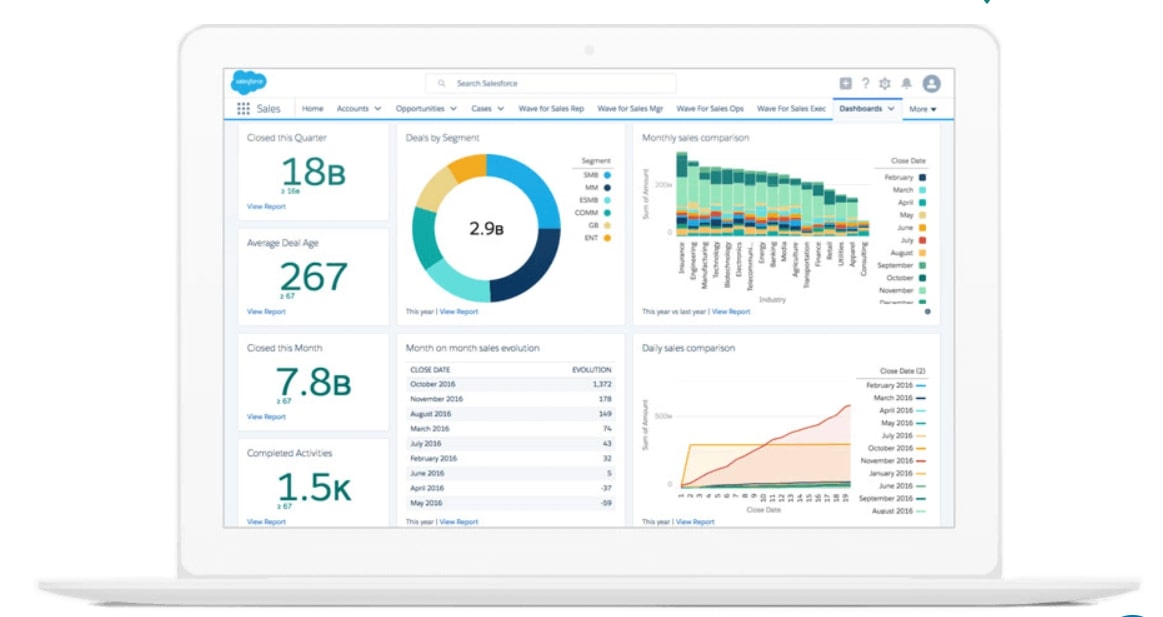ClickUp and Trello are two of the most popular project management software available in the market. Both platforms offer a range of features designed to help teams stay organized, collaborate effectively, and achieve their goals. However, there are some key differences between the two that may make one a better fit for your team than the other.
ClickUp is a comprehensive project management tool that offers a wide range of features, including task management, time tracking, calendars, and more. It’s designed to be highly customizable, allowing teams to create workflows that fit their specific needs. ClickUp also offers a range of integrations with other tools, such as Google Drive, Slack, and Zoom, making it easy to connect with other tools your team may be using.
Trello, on the other hand, is a more streamlined project management tool that focuses on visual organization. It uses a system of boards, lists, and cards to help teams keep track of tasks and collaborate effectively. Trello is known for its simplicity and ease of use, making it a popular choice for teams that don’t need all the bells and whistles of a more complex tool.
In this article, we’ll compare ClickUp and Trello to help you find which is best for you and your team. Now, let’s get started!
ClickUp vs Trello: Overview
ClickUp and Trello are both project management tools that offer a range of features to help teams stay organized and productive. ClickUp is a more comprehensive platform that includes task management, time tracking, and project planning tools, while Trello is a simpler tool that focuses on visual task management using boards and cards.
| Feature | ClickUp | Trello |
|---|---|---|
| Task Management | Subtasks, Customizable workflows, Time tracking, Reminders and recurring tasks, Priorities and urgency levels, Custom fields | Boards, Lists, Cards, Checklists, Due dates, Labels and tags, Power-ups for additional features |
| Project Management | Task management, Time tracking, Project planning tools, Project templates, Calendar view, Gantt charts, Custom fields | Boards, Lists, Cards, Customizable boards and lists, Card comments and attachments, Due dates, Checklists, Labels and tags, Power-ups for additional features |
| Customization | Custom fields, Views, and Workflows | Customizable boards and lists |
| Collaboration | Comments and mentions, Task assignments, Time tracking, Customizable workflows, Integrations | Comments and mentions, Task assignments, Labels and tags, Integrations |
| Data Analytics and Reporting | Advanced data visualization options, Custom reports, Real-time reporting, Data export, Integration with third-party tools, Advanced analytics | Basic data visualization options, No custom report creation, Real-time reporting, Data export (CSV and JSON), Integration with third-party tools |
| User Friendliness | Complex interface, More features and customization options | Simple and intuitive interface, Limited customization options |
| Integration | Integrates with over 1,000 apps and services, Custom integrations using API | Integrates with over 100 apps and services, Pre-built options |
One key difference between ClickUp and Trello is the level of customization available. ClickUp allows users to create custom fields, views, and workflows to fit their specific needs, while Trello has a more limited set of customization options. Additionally, ClickUp offers more advanced features such as Gantt charts and time tracking, which may be useful for larger or more complex projects.
ClickUp vs Trello: Similarities
ClickUp and Trello are both powerful project management tools that enable users to organize tasks and collaborate with team members. They share similar features such as task assignment, due dates, and progress tracking. In addition, both platforms have customizable boards and lists that can be tailored to fit specific project or team needs.
Moreover, both ClickUp and Trello offer integrations with other tools like Google Drive, Slack, and Zoom to streamline workflow and communication.
However, ClickUp offers more advanced features such as time tracking, Gantt charts, and custom fields, which make it a more comprehensive project management tool. Trello, on the other hand, prides itself on its simplicity and user-friendliness, making it a popular choice for teams that do not require advanced features.
Furthermore, both platforms have mobile apps for on-the-go access and offer free and paid plans with varying features and storage.
Overall, ClickUp and Trello are effective project management tools with similar core features, but ClickUp offers more advanced options for those who need more customization and organization.
ClickUp vs Trello: Differences
One key difference between ClickUp and Trello is the level of customization available. ClickUp allows users to create custom fields, views, and workflows to fit their specific needs, while Trello has a more limited set of customization options. Additionally, ClickUp offers more advanced features such as Gantt charts and time tracking, which may be useful for larger or more complex projects.
Another difference is that ClickUp has a more complex user interface compared to Trello. ClickUp offers more features and customization options, which can make it overwhelming for some users. Trello, on the other hand, has a simple and intuitive interface that is easy to use.
Task management is also a point of difference. ClickUp offers more advanced task management features than Trello. ClickUp allows users to create subtasks, dependencies, and time tracking. Trello, on the other hand, is more focused on visual task management with its Kanban-style boards.
Collaboration is another area where ClickUp and Trello differ. ClickUp allows users to assign tasks to specific team members, set permissions, and leave comments. Trello also allows users to assign tasks and leave comments, but it lacks some of the more advanced collaboration features of ClickUp.
Finally, ClickUp offers more integrations with other tools, such as Google Drive, Slack, and Zoom, making it easy to connect with other tools your team may be using. ClickUp also integrates with over 1,000 apps and services, while Trello offers integrations with around 100 apps and services.
ClickUp vs Trello: Key Features
When it comes to project management and task management features, both ClickUp and Trello offer a range of tools to help teams stay organized and productive.
ClickUp’s project management features include task management with subtasks and checklists, customizable workflows, time tracking and time estimates, project templates, calendar view, Gantt charts, and custom fields.
Trello’s project management features, on the other hand, include boards, lists, and cards, customizable boards and lists, card comments and attachments, due dates, checklists, labels and tags, and power-ups for additional features.
ClickUp’s project management features are more comprehensive than Trello’s, offering advanced features such as Gantt charts, time tracking, and custom fields. ClickUp also allows for more customization, with users able to create custom workflows and views. However, Trello’s focus on visual organization and simplicity makes it a popular choice for teams that prefer a more streamlined approach to task management.
If the team requires advanced features such as Gantt charts or custom fields, then ClickUp may be the better option. However, if the team prefers a more visual and intuitive approach to task management, then Trello may be the better choice.
Overall, ClickUp is a more advanced project management tool with more features and customization options. Trello is a simpler tool that is great for visual task management and collaboration.
ClickUp vs Trello: Data Analytics and Reporting
ClickUp and Trello are two popular project management tools that offer data analytics and reporting features. Here is a detailed comparison of their data analytics and reporting capabilities:
Data Visualization
ClickUp offers a wide range of data visualization options, including charts, graphs, and tables. Users can customize the visualizations to suit their needs and preferences. Trello, on the other hand, offers limited data visualization options, with only basic charts and graphs available.
Custom Reports
ClickUp allows users to create custom reports based on their specific needs. Users can choose from a variety of report templates or create their own custom reports from scratch. Trello, on the other hand, does not offer custom report creation options.
Real-time Reporting
ClickUp provides real-time reporting, which means that users can view the latest project data and metrics at any time. Trello also offers real-time reporting, but it is limited to basic metrics such as task completion rates and time spent on tasks.
Data Export
ClickUp allows users to export data in a variety of formats, including CSV, Excel, and PDF. Trello also offers data export options, but they are limited to CSV and JSON formats.
Integration with Third-party Tools
ClickUp integrates with a wide range of third-party tools, including Google Analytics, Zapier, and Slack. This allows users to import data from these tools and create more comprehensive reports. Trello also offers integrations with third-party tools, but they are more limited in scope.
Overall, ClickUp offers more robust data analytics and reporting features than Trello. While Trello is a great tool for basic project management, ClickUp is better suited for users who require more advanced data analytics and reporting capabilities.
ClickUp vs Trello: User Friendliness
When it comes to user friendliness, both ClickUp and Trello have their own strengths and weaknesses. Here are some angles to compare them:
- Interface: Trello has a simple and intuitive interface that is easy to navigate. ClickUp, on the other hand, has a more complex interface with more features and options, which can be overwhelming for some users.
- Customization: ClickUp offers more customization options than Trello, allowing users to tailor the platform to their specific needs. Trello, on the other hand, has a more limited set of customization options.
- Features: ClickUp has a wider range of features than Trello, including time tracking, calendars, and project templates. Trello, however, has a more streamlined set of features that are easy to use and understand.
- Collaboration: Both platforms offer collaboration features, but Trello’s interface is more conducive to team collaboration, with features like team boards and member assignments. ClickUp’s collaboration features are more geared towards individual task management.
Overall, both ClickUp and Trello are user-friendly platforms, but they cater to different types of users. Trello is ideal for those who want a simple and straightforward task management tool, while ClickUp is better suited for those who need more advanced features and customization options.
ClickUp vs Trello: Collaboration
Both ClickUp and Trello offer collaboration features that allow teams to work together on projects and tasks. However, there are some differences between the two platforms.
ClickUp offers a wide range of collaboration features, including:
- Comments and mentions: Users can leave comments on tasks and mention other team members to keep everyone in the loop.
- Task assignments: Tasks can be assigned to specific team members, making it clear who is responsible for each task.
- Time tracking: ClickUp allows users to track the time spent on each task, making it easier to manage workloads and deadlines.
- Customizable workflows: Users can create custom workflows to match their team’s specific needs and processes.
Trello, on the other hand, offers the following collaboration features:
- Comments and mentions: Like ClickUp, Trello allows users to leave comments on tasks and mention other team members.
- Task assignments: Tasks can be assigned to specific team members, and users can see who is responsible for each task at a glance.
- Labels and tags: Trello allows users to add labels and tags to tasks, making it easier to organize and filter tasks.
Overall, both ClickUp and Trello offer robust collaboration features that can help teams work together more effectively. However, ClickUp may be a better choice for teams that need more advanced features, such as custom workflows and time tracking. Trello may be a better choice for teams that prefer a simpler, more visual approach to task management.
ClickUp vs Trello: Integration
When it comes to third-party integrations, both ClickUp and Trello offer a wide range of options. ClickUp integrates with over 1,000 apps and services, including popular tools like Google Drive, Slack, and Zapier. Trello, on the other hand, offers integrations with over 100 apps and services, including Dropbox, Evernote, and Salesforce.
One key difference between the two platforms is the level of customization available for integrations. ClickUp allows users to create custom integrations using their API, which can be useful for businesses with unique needs. Trello, on the other hand, offers a more streamlined approach to integrations, with pre-built options that are easy to set up and use.
Another factor to consider is the quality of the integrations themselves. While both platforms offer a wide range of options, some users have reported issues with certain integrations not working as expected. In general, ClickUp has a reputation for offering more reliable integrations, although this can vary depending on the specific app or service being used.
Overall, both ClickUp and Trello offer robust third-party integration options that can help businesses streamline their workflows and improve productivity. The choice between the two will ultimately come down to individual needs and preferences, as well as the specific apps and services that are most important to your business.
Conclusion
In conclusion, both ClickUp and Trello are excellent project management tools that offer unique features and benefits.
ClickUp is better suited for larger teams and complex projects that require more advanced features such as time tracking, custom fields, and automation.
On the other hand, Trello is ideal for smaller teams and simpler projects that require a more visual and intuitive approach to project management.






